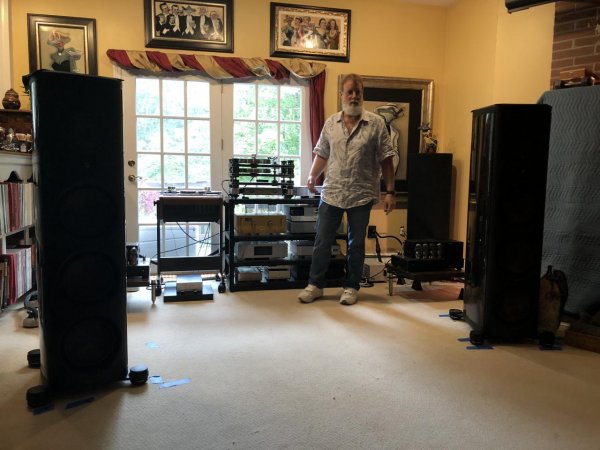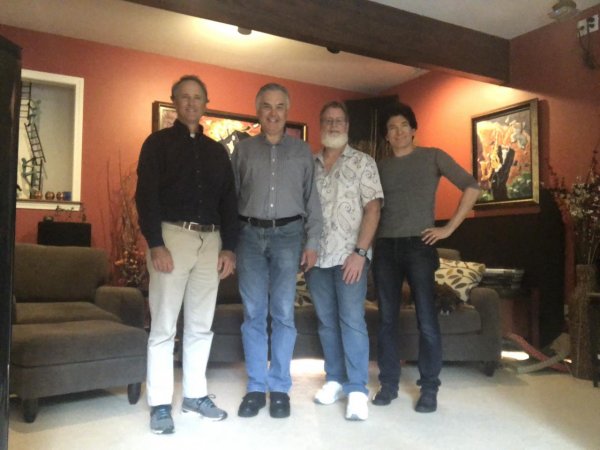While I was visiting PeterA in Boston Peter set up a listening appointment with Ian (MadFloyd). Peter and I spent some time with Ian ourselves, and then the three of us went out for lunch, and then Al M joined us for lunch and the four of us went back to Ian’s for additional listening.

Let me first dispel a misimpression I believe some people have about Ian’s efforts to evaluate components and to finalize his system. Many people know that Ian has hosted a revolving door of equipment in his home over the last couple of years. This may lead people to think that Ian is chasing his sonic tail or unclear of what is his sonic target. This is not the case. Ian grew up playing a musical instrument and he has a recording studio in his basement. Talking with Ian over the telephone previously and spending time listening to music with him in person makes it clear to me that Ian knows what he’s doing and that Ian has in mind a clear sonic goal he is trying to achieve.
Ian has what I consider to be one of the most challenging rooms I have ever seen. The left side wall is open and the rear wall is angled. I personally think that any room with a non-parallel front wall and rear wall is very difficult. Ian locates the MPros at a different distance to the front wall. (KeithR has a similarly difficult room, but Keith chooses to locate the speakers the same distance from the front wall. Only experimentation will allow one to learn which configuration is the lesser sonic compromise.)
I found Ian’s system to be very dynamic, very transparent and highly resolving. I think there is an excellent sense of presence. Low frequencies were powerful and detailed and very resolved. Ian’s system should sound great: every single component is top-of-the-line in its category.
Ian is very happy and content with his Magico MPro loudspeakers and his Convergent Audio Technology JL-7 amplifiers. Also in the system is a CH Precision phono stage.
Congratulations to Ian for getting a Studer 807! Ian uses a King Cello external tape repro amplifier. We compared my tape and Peter's LP of Ray Brown's Soular Energy. We all agreed the tape sounded more transparent, more dynamic and more in-the-room real. (It has been a personal mission of mine to enable Peter to hear for himself a great-sounding tape to explain why I am so focused on tape.)
We switched back-and-forth between the darTZeel NHB-18NS line preamplifier and the conrad-johnson GAT II line preamplifier. We also switched once between the Lyra Atlas SL and the Air Tight Opus 1 cartridges. So four different combinations were in play at different times.
We played among other things:
We spent a lot of time listening to the second half of “Pictures at an Exhibition” and “I’ve Got the Music in Me.” After Ian played the second half of Pictures with the Atlas SL through the darTZeel I literally applauded!
Ian then played the same track through the cj GAT II preamp. For some reason there was a significant diminution in dynamics, drive, energy and “live-ness” when we switched to the cj on that particular track. The magnitude of the difference was puzzling. On that particular track the cj sounded oddly lethargic.
Then we compared the Thelma Houston through both line stages, and here the darTZeel’s margin of superiority over the cj in terms of dynamics and drive was negligible.
Then Ian replaced the Atlas SL with the Opus 1. I preferred the Opus 1 over the Atlas SL (but I always do). I heard the Opus 1 to have more warmth and greater tonal color and harmonics and, maybe, slightly greater dimensionality than the Atlas SL.
We left for Ian the homework of figuring out why the dynamic/energy/life gap between the darTZeel and the cj varied so dramatically depending on the music being played.
Thank you, Ian, for hosting that afternoon listening session! I was very happy to meet you in person, and to hear your amazing system!
I am very happy for you that you are done on most critical components, with only one or two pieces left to go!


Let me first dispel a misimpression I believe some people have about Ian’s efforts to evaluate components and to finalize his system. Many people know that Ian has hosted a revolving door of equipment in his home over the last couple of years. This may lead people to think that Ian is chasing his sonic tail or unclear of what is his sonic target. This is not the case. Ian grew up playing a musical instrument and he has a recording studio in his basement. Talking with Ian over the telephone previously and spending time listening to music with him in person makes it clear to me that Ian knows what he’s doing and that Ian has in mind a clear sonic goal he is trying to achieve.
Ian has what I consider to be one of the most challenging rooms I have ever seen. The left side wall is open and the rear wall is angled. I personally think that any room with a non-parallel front wall and rear wall is very difficult. Ian locates the MPros at a different distance to the front wall. (KeithR has a similarly difficult room, but Keith chooses to locate the speakers the same distance from the front wall. Only experimentation will allow one to learn which configuration is the lesser sonic compromise.)
I found Ian’s system to be very dynamic, very transparent and highly resolving. I think there is an excellent sense of presence. Low frequencies were powerful and detailed and very resolved. Ian’s system should sound great: every single component is top-of-the-line in its category.
Ian is very happy and content with his Magico MPro loudspeakers and his Convergent Audio Technology JL-7 amplifiers. Also in the system is a CH Precision phono stage.
Congratulations to Ian for getting a Studer 807! Ian uses a King Cello external tape repro amplifier. We compared my tape and Peter's LP of Ray Brown's Soular Energy. We all agreed the tape sounded more transparent, more dynamic and more in-the-room real. (It has been a personal mission of mine to enable Peter to hear for himself a great-sounding tape to explain why I am so focused on tape.)
We switched back-and-forth between the darTZeel NHB-18NS line preamplifier and the conrad-johnson GAT II line preamplifier. We also switched once between the Lyra Atlas SL and the Air Tight Opus 1 cartridges. So four different combinations were in play at different times.
We played among other things:
"Send in the Clowns" by Bill Henderson, Live at the Times (Jazz Planet Records/Classic Records)
"First We Take Manhattan" and "Bird on a Wire" by Jennifer Warnes, Famous Blue Raincoat (Rock the House Records/Classic Records) (I know this is a digital recording.)
“Pictures at an Exhibition” on The Power of the Orchestra, Rene Leibowitz, RPO, Chesky RC30
”I've Got the Music in Me" by Thelma Houston, I've Got the Music in Me (Sheffield Lab 2)
"Hallelujah" by Jeff Buckley, Grace.
"First We Take Manhattan" and "Bird on a Wire" by Jennifer Warnes, Famous Blue Raincoat (Rock the House Records/Classic Records) (I know this is a digital recording.)
“Pictures at an Exhibition” on The Power of the Orchestra, Rene Leibowitz, RPO, Chesky RC30
”I've Got the Music in Me" by Thelma Houston, I've Got the Music in Me (Sheffield Lab 2)
"Hallelujah" by Jeff Buckley, Grace.
We spent a lot of time listening to the second half of “Pictures at an Exhibition” and “I’ve Got the Music in Me.” After Ian played the second half of Pictures with the Atlas SL through the darTZeel I literally applauded!
Ian then played the same track through the cj GAT II preamp. For some reason there was a significant diminution in dynamics, drive, energy and “live-ness” when we switched to the cj on that particular track. The magnitude of the difference was puzzling. On that particular track the cj sounded oddly lethargic.
Then we compared the Thelma Houston through both line stages, and here the darTZeel’s margin of superiority over the cj in terms of dynamics and drive was negligible.
Then Ian replaced the Atlas SL with the Opus 1. I preferred the Opus 1 over the Atlas SL (but I always do). I heard the Opus 1 to have more warmth and greater tonal color and harmonics and, maybe, slightly greater dimensionality than the Atlas SL.
We left for Ian the homework of figuring out why the dynamic/energy/life gap between the darTZeel and the cj varied so dramatically depending on the music being played.
Thank you, Ian, for hosting that afternoon listening session! I was very happy to meet you in person, and to hear your amazing system!
I am very happy for you that you are done on most critical components, with only one or two pieces left to go!


